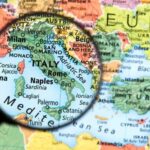Italy, a country renowned for its stunning landscapes, rich cultural heritage, and delectable cuisine, has always been a popular destination for travelers from around the world. However, in recent months, the global COVID-19 pandemic has forced Italy to take drastic measures to curb the spread of the virus within its borders. These measures have had a significant impact on both domestic and international travelers, as restrictions on movement and entry requirements have been implemented.
The allure of Italy as a tourist destination cannot be overstated. From iconic landmarks such as the Colosseum in Rome and the canals of Venice to picturesque coastal towns like Amalfi and Cinque Terre, visitors flock to this Mediterranean gem year-round. Tourism plays a vital role in Italy’s economy, contributing over 13% to its gross domestic product (GDP) and employing millions of people in various sectors.
However, with the recent surge in COVID-19 cases across Italy, the government has taken swift action to contain the virus. Travel restrictions have been imposed on both domestic and international travelers to prevent further spread. These measures include limitations on interregional travel for Italians themselves and stringent requirements for foreigners wanting to visit the country.
Amidst these challenging times, it is crucial for travelers to stay informed about these restrictions in order to make informed decisions regarding their travel plans. This article will delve into the specific measures implemented by Italy for both domestic and international travelers and explore their impact on the tourism industry. Additionally, alternatives for individuals who may have had plans to visit Italy will be suggested along with a discussion on future outlooks for lifting these travel restrictions.
As we navigate through this ever-evolving global health crisis together, it is important to remember that our collective efforts are aimed at safeguarding public health. By adhering to travel restrictions and remaining vigilant about our own health practices, we can work towards a brighter future where leisurely travels and exploration can resume.
History of Italy as a popular tourist destination
Italy has long been renowned as a popular tourist destination due to its rich cultural heritage, breathtaking landscapes, and world-class cuisine. The country’s historical significance, with iconic landmarks such as the Colosseum in Rome, the canals of Venice, and the ruins of Pompeii, has attracted millions of visitors from all over the globe.
Italy’s tourism industry has been a significant contributor to the country’s economy. In 2019 alone, it generated approximately 13% of Italy’s GDP and provided employment for millions of people. The allure of Italy lies not only in its historical sites but also in its vibrant cities, picturesque countryside, and renowned art galleries and museums.
Visitors to Italy have always been drawn to its diverse regions, each with its own distinct culture, traditions, and attractions. From exploring the charming villages of Tuscany to soaking up the sun on the Amalfi Coast or enjoying skiing in the Italian Alps, there is something for everyone in this captivating country.
Unfortunately, the COVID-19 pandemic has had a devastating impact on Italy’s tourism industry. With travel restrictions and lockdown measures implemented worldwide, international tourism came to a halt. As a result, Italy experienced an unprecedented decline in tourist arrivals, resulting in billions of dollars in lost revenue.
Italy’s decision to impose travel restrictions was necessary to curb the spread of COVID-19 within its borders. While these measures are crucial for public health and safety, they have undoubtedly taken a toll on both domestic and international travelers who had hoped to experience all that Italy has to offer.
In response to these challenges faced by both tourists and businesses dependent on tourism revenue, Italian authorities have begun exploring creative solutions to support local economies. Initiatives such as offering virtual tours of famous landmarks and promoting domestic tourism have been implemented to keep interest alive while travel remains restricted.
Overall, understanding the history of Italy as a popular tourist destination helps us appreciate its significance not only culturally but also economically. As we navigate the challenges posed by the pandemic, it is important to remember the resilience of Italy’s tourism industry and remain hopeful for a future when travelers can once again experience the magic of this captivating country.
| Statistic | Data |
|---|---|
| Contribution of tourism to Italy’s GDP in 2019 | Approximately 13% |
| Employment generated by Italy’s tourism industry | Millions of people |
Current situation and measures implemented
Italy, like many other countries, has been dealing with a surge in COVID-19 cases in recent weeks. The increase in infections prompted the Italian government to take decisive action and impose travel restrictions in an effort to contain the spread of the virus. These measures have had a significant impact on both domestic travelers within Italy and international visitors.
In response to the rise in cases, Italy implemented a tiered system that categorizes regions based on their level of risk. Each region is assigned a color – yellow, orange, or red – depending on the severity of the situation. Different restrictions are then imposed based on these colors. For example, in red zones with higher infection rates, movement is limited and non-essential businesses are closed.
One key measure that has been put in place is a restriction on interregional travel. Italians are now prohibited from traveling between different regions unless it is for essential reasons such as work or health emergencies. Additionally, public transportation services have been reduced, further limiting movement within the country.
These measures were deemed necessary due to the alarming increase in COVID-19 cases across Italy. The number of daily infections reached record highs in certain regions, placing a strain on healthcare systems and raising concerns about overwhelming hospitals. By imposing travel restrictions and reducing mobility, authorities hope to slow down the transmission of the virus while allowing healthcare facilities to cope with the influx of patients.
Current Situation and Measures Implemented
| Measures Implemented | Description |
|---|---|
| Interregional Travel Restrictions | Italians are prohibited from traveling between different regions unless for essential reasons. |
| Reduction of Public Transportation | Public transportation services have been reduced to limit movement within the country. |
Italy’s travel restrictions for domestic travelers
As part of its efforts to curb the spread of COVID-19, Italy has implemented travel restrictions not only for international visitors but also for domestic travelers within the country. These measures are aimed at minimizing movement and preventing the virus from spreading across regions.
One of the key restrictions imposed on Italians is interregional travel. Under these measures, individuals are not allowed to leave their region unless they have a valid reason such as work, health or emergency situations. This means that Italians cannot freely explore other parts of the country or visit family and friends in different regions without a legitimate purpose.
Moreover, Italy has also introduced limitations on public transportation. In an effort to reduce crowding and maintain physical distancing, capacity on buses, trains, and trams has been significantly reduced. This may result in longer wait times and limited availability of seats for domestic travelers who need to use public transportation for essential purposes.
These restrictions on domestic travel have been put in place to prevent the further spread of COVID-19 within Italy. By limiting movement between regions, authorities hope to contain localized outbreaks and avoid overwhelming healthcare systems in certain areas. It is important for Italians to comply with these measures in order to protect themselves and others from contracting or spreading the virus.
Travel restrictions for international visitors
Italy has implemented various travel restrictions for international visitors in an effort to control the spread of COVID-19. These measures include quarantine requirements, testing protocols, and entry restrictions. It is important for potential travelers to familiarize themselves with these specific measures before planning a trip to Italy.
Quarantine requirements
One of the key measures put in place by Italy is a mandatory quarantine period for certain travelers. Currently, individuals arriving from high-risk countries are required to undergo a 14-day quarantine upon arrival. This means that visitors must isolate themselves in their accommodation and avoid contact with others during this period.
Failure to comply with the quarantine requirements may result in penalties or even deportation. It is essential for travelers to carefully review the list of high-risk countries and ensure they understand the quarantine regulations before booking their trip.
Testing protocols
In addition to quarantine requirements, Italy also has specific testing protocols for international visitors. Travelers from certain countries may be required to provide proof of a negative COVID-19 test result taken within a specified timeframe before their departure.
The testing requirements may vary depending on the traveler’s country of origin or recent travel history. It is crucial for individuals intending to visit Italy to stay updated on any changes or updates regarding testing protocols as they plan their trip.
Entry restrictions
Italy has implemented entry restrictions aimed at controlling the influx of international travelers. Non-essential travel from some countries may be restricted, while essential travel such as work-related or health-related reasons may be permitted under certain conditions.
Additionally, certain categories of individuals, such as Italian residents and citizens returning home, may have different entry requirements compared to other travelers. It is advisable for foreigners planning to visit Italy to check the latest information on entry restrictions and consult with relevant authorities or embassies before traveling.
It is important for prospective travelers considering a trip to Italy to thoroughly research and understand the specific measures in place for foreigners. This includes familiarizing themselves with quarantine requirements, testing protocols, and entry restrictions. By staying informed and adhering to these restrictions, travelers can contribute to the efforts to control the spread of COVID-19 and ensure a safe experience for themselves and others.
Impact on the tourism industry
The travel restrictions imposed by Italy in response to the COVID-19 pandemic have had a significant impact on the tourism industry. Italy has long been known as one of the most popular tourist destinations in the world, attracting millions of visitors each year due to its rich cultural heritage and breathtaking attractions. However, with the implementation of these travel restrictions, businesses in the tourism sector have been severely affected.
One of the immediate consequences of these travel restrictions is the closure of businesses related to tourism. Hotels, restaurants, tour operators, and other establishments heavily reliant on tourist footfall have experienced a sharp decline in revenue and have had to shutter their doors. This has not only caused financial hardship for business owners but also resulted in job losses for many employees who work in these sectors.
The closure of businesses and loss of jobs have led to serious economic repercussions for local communities that rely on tourism as a major source of income. Small towns and cities that heavily depend on international travelers have seen a drastic decrease in economic activity. There has been a ripple effect across various industries such as transportation, retail, and entertainment that cater to tourists.
Overall, the impact on the tourism industry in Italy has been devastating. To mitigate this, various measures such as government support programs and initiatives aiming to boost domestic tourism have been put into place. However, it will take time for the industry to fully recover once travel restrictions are lifted. In the meantime, stakeholders are encouraged to adapt their business models by focusing on local clientele or exploring alternative revenue streams until international travel resumes.
- The closure of businesses related to tourism
- Job losses in the tourism sector
- Economic repercussions and decline in income for local communities
- Ripple effect on various industries
- Government support programs
- Promotion of domestic tourism
- Adapting business models and exploring alternative revenue streams
Alternatives for travelers
Italy’s travel restrictions have made it challenging for individuals who had been planning a trip to the country. However, there are still plenty of alternatives for travelers seeking a European getaway. Whether you are looking to explore other countries or postpone your travel plans, there are various options to consider.
One alternative is to explore other European destinations. Europe offers a wealth of diverse cultures, stunning landscapes, and historical landmarks that can rival those found in Italy. Consider visiting countries such as France, Spain, Greece, or Germany. These countries offer their own unique attractions and experiences that can make for an unforgettable trip.
Another option is to postpone your travel plans. If you had your heart set on visiting Italy, it may be worth considering rescheduling your trip for a later date when travel restrictions ease. This allows you to still fulfill your dream of experiencing Italy’s rich cultural heritage and its famous landmarks without compromising on safety or missing out on the full experience due to limited access.
It’s important to stay informed about the latest developments and regulations in each country before making any decisions. Keep an eye on travel advisories and guidelines issued by government authorities and health organizations. Flexibility and adaptability are key during these uncertain times, so be prepared to adjust your plans accordingly based on the evolving situation.
While the current travel restrictions may be disappointing for those who had planned a trip to Italy, there are still alternatives to satisfy your wanderlust. Explore other European destinations or consider postponing your trip until it is safer and more convenient to visit Italy. Remember, the priority is safeguarding public health, and by being vigilant and adaptable in our travel plans, we can contribute to minimizing the spread of COVID-19 and protecting ourselves and others.
Future outlook and potential easing of restrictions
The future outlook for travel restrictions in Italy remains uncertain as the country continues to monitor the spread of COVID-19 and its impact on public health. The government is closely evaluating the number of cases, vaccine distribution, and other relevant factors to determine when it will be safe to ease travel restrictions. While no specific timelines have been announced, there are indications that some measures could potentially be relaxed in the coming months.
One factor that may contribute to a potential easing of travel restrictions is the successful implementation of vaccination campaigns. As more individuals receive their vaccines and gain immunity against COVID-19, there may be a reduced risk of transmission within Italy and from international travelers. This could pave the way for looser restrictions in the future.
Another aspect that will influence the lifting of travel restrictions is the overall trend in COVID-19 cases. If Italy continues to see declining numbers and a decrease in hospitalizations, it may signal that the situation is under control and allow for a gradual reopening. However, any sudden spikes or new variants of concern could result in further delays or even tightening of restrictions.
It’s important to note that any potential easing of travel restrictions will likely occur in a phased approach. This means that certain regions or countries may see their limitations lifted before others based on their respective data on COVID-19 cases and public health measures. Travelers should stay updated with official announcements from Italian authorities and consult with travel advisories before making any plans.
To ensure an effective transition out of current travel restrictions, Italy will continue to closely monitor the situation through surveillance systems, testing protocols, contact tracing efforts, and close collaboration with international health organizations. This dynamic approach allows for flexibility in responding to emerging trends or challenges while prioritizing public health.
As travelers eagerly anticipate a return to normalcy, it is essential to remain patient and adaptable during these uncertain times. Flexibility in travel plans and thorough research about alternative destinations or postponed visits to Italy can help mitigate disappointment and ensure a safe and enjoyable travel experience in the future.
Italy’s commitment to safeguarding public health remains paramount, and its gradual reopening will be guided by the best available scientific evidence and the well-being of its citizens and visitors alike.
Conclusion
In conclusion, Italy’s decision to impose travel restrictions is vital in safeguarding public health during these uncertain times. The recent surge in COVID-19 cases in Italy has prompted the government to implement measures to curb the spread of the virus and protect its citizens. These restrictions not only apply to domestic travelers but also extend to international visitors.
The travel restrictions for Italians themselves include limitations on interregional travel and the use of public transportation. This is a necessary step in preventing the further spread of the virus within the country. Additionally, specific measures have been put in place for foreigners wanting to visit Italy, such as quarantine requirements, testing protocols, and entry restrictions. While these restrictions may be frustrating for travelers, they are essential in controlling the transmission of COVID-19 and ensuring public safety.
The tourism industry has been severely impacted by these travel restrictions, with businesses closing down and many individuals losing their jobs. The economic repercussions have been significant, but prioritizing public health remains paramount. For those who had planned a trip to Italy, alternatives such as exploring other European destinations or postponing travel plans should be considered.
Looking ahead, it is important to monitor the situation and follow updates from authorities regarding potential easing of travel restrictions. As countries continue their vaccination efforts and infection rates decrease, there is hope that travel will gradually return to normalcy. In the meantime, travelers must remain vigilant and adaptable in navigating these uncertain times.
Overall, Italy’s travel restrictions are crucial for safeguarding public health and minimizing the spread of COVID-19. It is essential for travelers to prioritize their own safety as well as the wellbeing of others by abiding by these measures. By remaining vigilant and adaptable during these challenging times, we can collectively work towards overcoming this global pandemic while still enjoying our love for travel in safer times ahead.

I’m a passionate traveler, writer, and Italophile. My fascination with Italy’s history, art, and culture has led me on countless adventures across the Italian landscape. Through “I Live Italy,” I share my love for this extraordinary country and aims to inspire others to explore its boundless beauty.





